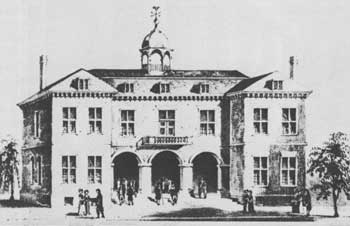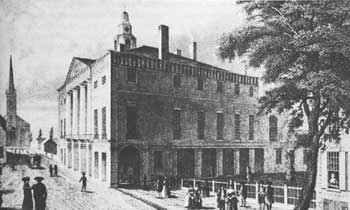







Survey of
Historic Sites and Buildings
 |
FEDERAL HALL NATIONAL MEMORIAL New York |
 Federal Hall National Memorial |
| ||
This memorial commemorates two earlier buildings on this site that were the scene of momentous events vital to American freedom and the formation of the Union. City Hall, the first structure, was a Capitol of the United States under the Articles of Confederation; enlarged and renamed Federal Hall, it was the first Capitol under the Constitution. The present edifice, erected in the period 1835-42, was designated as Federal Hall National Memorial in the 20th century.
In City Hall the Continental Congress issued the call for the Constitutional Convention at Philadelphia; received, debated, and transmitted the Constitution to the States for ratification; and prepared for the transfer of power to the new Government. On the balcony of Federal Hall, George Washington took the oath of office as our first President. In its chambers, the First Congress created the original governmental departments as well as the Federal judiciary system, and drafted and submitted the Bill of Rights to the States for approval.
City Hall, begun about 1699 to replace an earlier structure on another site, the Dutch Stadt Huys, was completed and occupied in 1703 or 1704 and remodeled in 1763. In time, the building also accommodated the colonial and State governments.
In 1734 newspaper publisher John Peter Zenger, charged with publishing "seditious libels," was imprisoned by the colonial Governor in the garret of City Hall. The following year, he was tried in the hall. His attorney, Andrew Hamilton, won his acquittal, an important precedent for freedom of speech and the press. In October 1765 the Stamp Act Congress, consisting of delegates from 9 of the 13 Colonies, convened in the hall. Offering the first united colonial opposition to English policy, it sent an address to the King, petitioned Parliament, and drew up a Declaration of Rights and Grievances.
 |
| Federal Hall National Memorial. (National Park Service (Boucher, 1975).) |
During the 1770's Philadelphia displaced New York as the prime meetingplace for intercolonial gatherings and hosted both the First and Second Continental Congresses. During the War for Independence, from 1776 to 1783, British forces and Loyalists controlled New York City. City Hall became a guardhouse and housed a military court.
In late 1784 the Continental Congress, meeting in Trenton, N.J., selected New York City as the seat of Government; and in January began meeting in City Hall, at the invitation of the city government. In February 1787 Congress approved the resolution of the Annapolis Convention that called for the convening of a Constitutional Convention in Philadelphia. During the Convention, some delegates journeyed to and from New York to sit in the Congress. During this period, it passed the Northwest Ordinance, which provided for the government of the Territory Northwest of the Ohio River. After the Convention, Congress received and forwarded the Constitution to the States for ratification.
In September 1788 the Continental Congress designated New York City as the U.S. Capital under the Constitution. The city council promptly offered the continued use of City Hall, and hired Maj. Pierre Charles L'Enfant to renovate and enlarge it. The work was largely completed before Congress met the following spring. Filling in the space between the two front wings, which projected from a central block, L'Enfant erected an imposing second-floor balcony in the middle of the new front facade. Large extensions were also made at the rear of the building, and a new roof was built for the entire structure. In the repartitioned interior, spacious chambers were provided for both the House and Senate as well as an imposing office for the President. Inside and out, the building was ornately decorated to celebrate American freedom and Union.
 |
| City Hall, the predecessor of Federal Hall. (From a drawing (undated) apparently executed by David Grimm. National Archives.) |
In the new structure, renamed Federal Hall, the First Congress held its initial sessions early in April 1789, counted the electoral votes, and announced the election of George Washington as President and John Adams as Vice President. On April 30 a congressional committee escorted Washington from his local residence to Federal Hall. There, on the front balcony, overlooking throngs of people at the intersection of Broad and Wall Streets, Robert R. Livingston, Chancellor of the State of New York, administered the Presidential oath. Upon the ceremony's conclusion, as the flag was raised on the cupola of the building, cheers filled the air, church bells rang out, and guns saluted from the harbor. Shortly thereafter, inside the building, from the dais of the Senate Chamber, Washington delivered his inaugural address.
Between July and September, Congress created the Supreme Court and other courts and the Departments of State, War, and Treasury, as well as the office of Attorney General; and adopted and transmitted the Bill of Rights to the States for ratification. One of Congress' last acts in this building, in July 1790, was selection of a 10-mile square tract along the Potomac as the site of a permanent national Capital, to be called the District of Columbia. In August 1790 the Federal Government moved from New York to Philadelphia, which was to serve as the interim Capital.
 |
| Federal Hall. ca. 1789. (Engraving (undated) by Hatch & Smillie, after a drawing (undated) by Diederick Knickerbocker, Jr., after an engraving (undated) by Cornelius Tiebout. National Archives.) |
During the following two decades, Federal Hall was utilized only for State and city offices. In 1796 the legislature relocated to Albany, and in 1811 the city also vacated the deteriorating building. The following year, it was demolished.
Commercial buildings were soon erected on the site. In 1816 or 1817 the Federal Government acquired or leased them for temporary use as a customhouse. The permanent New York City Custom House, built at the site in the period 1835-42, is an outstanding example of Greek Revival architecture. In 1862 it became the United States Sub-Treasury. Later, it housed the Federal Reserve Bank of New York and a number of minor governmental offices. When most of these were relocated, local civic and patriotic organizations conceived the idea of preserving the structure as a memorial to the founding of our Federal form of Government. The building was designated as a national historic site in 1939 and became a national memorial in 1955.
Federal Hall National Memorial is administered by the National Park Service with the cooperation of the Federal Hall Memorial Associates, Inc. Extensive exhibits trace the historical events associated with the site.
 |
 |
http://www.cr.nps.gov/history/online_books/constitution/site16.htm
Last Updated: 29-Jul-2004